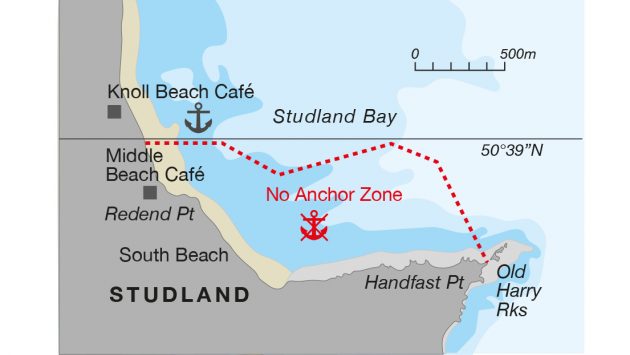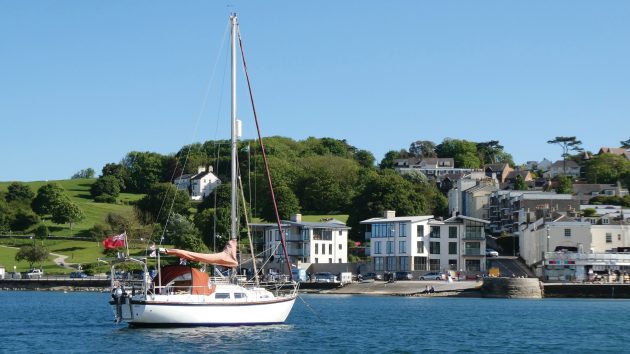Studland’s valuable anchorage is now a no-anchor zone, so Ken Endean looks at alternatives for the cruising sailor
Studland’s voluntary no-anchor zone, enforced by the Marine Management Organisation (MMO), has been designated to protect the seagrass growing in the southern part of the bay.
The new restriction will have an obvious impact on both inshore recreation in the bay, which has traditionally been Poole’s playground, and coastal cruising, for which Studland has always been a valuable refuge in strong westerly winds.
Compliance is voluntary but there is a threat of compulsion if boat owners do not cooperate. The MMO has stated that there will be no prohibition on emergency use; it is not clear whether this would include sheltering from a gale, although an exact definition of ‘emergency’ is not critical while the rule remains voluntary.
Are the boundaries clear enough?
When we visited Studland in August 2022, about a dozen boats were anchored inside the new zone: behaviour that could provide an excuse for a compulsory anchoring ban. Most were powerboats but four yachts were in a group off Redend Point. Their skippers may have thought they were clear of the zone, because some reports have described it as being the area in front of the South Beach, but the northern limit is actually much further north.
The coordinates of the zone have been published and its boundary is now being shown on charts, but if the MMO really wants the voluntary ban to work it would
surely be sensible to lay marker buoys.
Within the no-anchor zone there were 10 new ‘eco moorings’, installed in 2022, and more in 2023, by marina operator Boatfolk, which are currently free to use. However, they are a long way offshore, where dinghies get into difficulties when strong winds are screaming off Ballard Down.

Studland Bay, looking north from Redend Point. The no-anchor zone extends almost to the anchored yacht, at right of centre.
For our visit, we anchored by GPS on the latitude of 50º39’N (see chartlet on p76) and close inshore, where trees provide enhanced shelter. In this northern area the sea bed is irregular, with shallow patches, and wave action can shift the banks. Even so, at our position the bed level was 1m below Chart Datum, giving a low water depth of 2.2 m on a medium tide.
In the past, we would land at South Beach for easy access to a pub, a village shop and a water tap. From the Middle Beach it is still only a short walk to the shop or the Bankes Arms, and there is a public tap near the Knoll Beach Café, so Studland still scores points as a useful passage anchorage. However, in bad weather, swell rolls in around Handfast Point. Swell waves are larger in the north of the bay and that is why both yachts and seagrass have favoured the southwest corner.
In these conditions, or if the wind backs towards the southeast, Poole Harbour is now an obvious bolthole, but most of its anchorages lack good windbreaks.

Swanage Bay wraps around a good anchorage. It may be more built-up than Studland but still makes for a pleasant and well-sheltered stop
A pleasant diversion
Swanage is a good alternative and although it experiences swell this may be no worse than in the north part of Studland Bay. For much of its history Swanage served as a port for shipping out Purbeck stone, despite having no harbour walls: an indication that on most days, at least in westerly winds, the sea state should be tolerable.
West of the timber pier, which is used by excursion vessels and local dive boats, Swanage Boat Hire operates a dozen visitor moorings and a water taxi service from a private landing pontoon.

With care, yachts can anchor close inshore off Swanage Town
There is also plenty of space in the bay for anchoring; the holding is good in most places, but with a few stony patches where an anchor may scrabble for grip, so it pays to check it’s properly embedded. As at Studland, the tidal range is tiny – only 0.5m at mean neaps – and intelligent use of the echo sounder should allow a yacht to anchor close to shore in the cosy southwest corner of the bay.
A low ground swell that is too gentle to trouble anchored boats might form surging breakers on the beach, so when going ashore by tender, choose the landing point with care. The most popular spot is a small beach and sloping revetment beside an old stone jetty. If that is unsuitable, Swanage Sailing Club has a gently shelving beach on the eastern side of the pier.

Further east, the local fishermen have the most civilised facilities, with a slipway and two concrete jetties alongside the lifeboat station, tucked in under Peveril Point where swell is generally subdued.
There are shops of all kinds, including a selection of chippies, and a water tap near the stone jetty. The hospitable sailing club has showers and prepares meals on race nights.
If you are held up by weather, waiting for a favourable wind, take the family on the heritage railway or have a walk around and expect to see some architectural eccentricities. When quarried stone was sent to London, the contractors brought back pre-used items from their demolition work to serve as municipal decorations in their hometown.

The location is convenient for overnight stops before long passages. For south-bound departures, the distance to Alderney is only 55 miles and a yacht will be in east or west-flowing tidal streams for most of the trip, whatever the start time. When heading west, tidal tactics are more important, and rounding Anvil Point against the last of the east-flowing flood will allow a yacht to catch the first of the westerly current.
Everything to hand
The Channel ebb should then push her rapidly west, right past Portland and well into Lyme Bay, before it turns. Swanage also makes an appealing destination when running for shelter before a westerly blow. As soon as you hook in around Peveril Ledge, the water seems wonderfully flat, and within 15 minutes you can be swinging peacefully at anchor. If nobody feels like cooking, there are those chippies on the shore!
Enjoyed reading this?
A subscription to Yachting Monthly magazine costs around 40% less than the cover price.
Print and digital editions are available through Magazines Direct – where you can also find the latest deals.
YM is packed with information to help you get the most from your time on the water.
-
-
- Take your seamanship to the next level with tips, advice and skills from our experts
- Impartial in-depth reviews of the latest yachts and equipment
- Cruising guides to help you reach those dream destinations
-
Follow us on Facebook, Twitter and Instagram.






